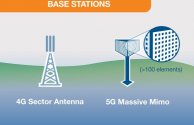Just curious are there any concept of the future radar beyond AESA already?
Possibly MIMO radars.
Just curious are there any concept of the future radar beyond AESA already?
Can you explain what is the significance of MIMO in the military field? What new capabilities would a MIMO radar on a fighter jet offer in comparison to a non-MIMO radar?To explain MIMO radars:
To explain the essential difference between AESA vs. PESA, it is in the centralization of the amplifiers (PESA) vs. the decentralized distribution of the amplifiers (AESA).
Between MIMO and non-MIMO radars, it is in the centralization of the signal-waveform generator (non-MIMO) vs. the decentralization and distribution of the signal-waveform generator. To explain, even in AESA, the whole array even with thousands of transmitters, each with a amplifier on their own, are still coordinated by a single waveform generator that serves like a single heartbeat for the entire body. In MIMO, each transmitter has its own waveform generator. Moreover, in AESA, each module has its own Rx/Tx, but in MIMO, Rx and Tx are located separately. This means that each transmitter can transmit a different waveform separately and uniquely from each other, whereas in an AESA array, every Tx element sends out the same waveform.
Some basic wiki information.
If this sounds a bit familiar, this is sort of like 5G. Telecom are full of MIMO arrays from your base station to your wifi routers to your satellite communications, a good example would be Starlink.
There are also many papers and books done in China on that subject and its easy to google them up.
I don't see this replacing AESA for its traditional applications like aerial surveillance. Where I see MIMO radars being used at is with drones, UAVs and automobiles.
Can you explain what is the significance of MIMO in the military field? What new capabilities would a MIMO radar on a fighter jet offer in comparison to a non-MIMO radar?
Would a MIMO-equipped fighter jet have a revolutionary leap on detection/tracking/communication/EW/etc ?
Thanks, also that study you linked is great. I am reading it now and it is quite informativeYou mean if MIMO radars are equipped on UAVs and robot wingmen? Ability to detect stealthier, slower moving objects, low probability of intercept and so on.
There is also the use of SIAR in the South China Seas islands for counter stealth.
Other applications.
As far as I know MIMO radars are being used in robotaxi/ adas imaging radars.To explain MIMO radars:
To explain the essential difference between AESA vs. PESA, it is in the centralization of the amplifiers (PESA) vs. the decentralized distribution of the amplifiers (AESA).
Between MIMO and non-MIMO radars, it is in the centralization of the signal-waveform generator (non-MIMO) vs. the decentralization and distribution of the signal-waveform generator. To explain, even in AESA, the whole array even with thousands of transmitters, each with a amplifier on their own, are still coordinated by a single waveform generator that serves like a single heartbeat for the entire body. In MIMO, each transmitter has its own waveform generator. Moreover, in AESA, each module has its own Rx/Tx, but in MIMO, Rx and Tx are located separately. This means that each transmitter can transmit a different waveform separately and uniquely from each other, whereas in an AESA array, every Tx element sends out the same waveform.
Some basic wiki information.
If this sounds a bit familiar, this is sort of like 5G. Telecom are full of MIMO arrays from your base station to your wifi routers to your satellite communications, a good example would be Starlink.
There are also many papers and books done in China on that subject and its easy to google them up.
I don't see this replacing AESA for its traditional applications like aerial surveillance. Where I see MIMO radars being used at is with drones, UAVs and automobiles.
Tank APS?I don't see this replacing AESA for its traditional applications like aerial surveillance. Where I see MIMO radars being used at is with drones, UAVs and automobiles.
As far as I know MIMO radars are being used in robotaxi/ adas imaging radars.


Best of all, the could be converted into clothe racks to fool overhead satellites.An illustration from a paper published in the journal Modern Radar. I don't have access to the paper, but according to the Weibo user who shared it, it shows a new meter wave anti-stealth radar design from. The design is very compact (as small as racks used for hanging laundries to dry) and can be easily concealed. It works by splitting the normally large meter-wave antennas into smaller parts, which are then placed some distance apart and linked via fiber optics. This arrangement can cover a larger area, but the drawback is increased noise. The key breakthrough was new signal processing algorithms and techniques to filter out the background noise.

